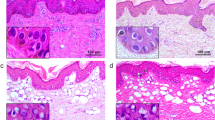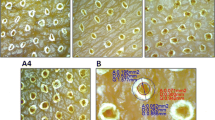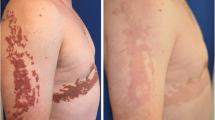Abstract
Optical pulses from picosecond lasers can be delivered to the skin using microlens array (MLA) optics or a diffractive beam splitter to generate multiple, focused, high-intensity, micro-injury zones in the epidermis and dermis. The aim of our study was to histopathologically and immunohistochemically evaluate the patterns of 532- and 1064-nm MLA-type, picosecond laser-induced tissue reactions in human skin immediately after treatment. Picosecond neodymium:yttrium–aluminum–garnet (Nd:YAG) laser treatment using an MLA-type beam at the wavelengths of 532 nm and 1064 nm was delivered ex vivo to human skin. Irradiated skin specimens were then microscopically analyzed after hematoxylin and eosin staining and CD31 and Melan-A immunostaining. A single pulse of 532-nm MLA-type, picosecond laser treatment elicited cystic cavitation lesions at sizes of 83.4 ± 16.5 μm × 70.2 ± 17.3 μm (31-mm distance step) and 91.0 ± 44.7 μm × 81.2 ± 36.3 μm (48-mm distance step) in the epidermis and papillary dermis. Meanwhile, a single pulse of 1064-nm laser treatment generated cystic cavitation lesions at sizes of 107.0 ± 18.1 μm × 83.3 ± 37.4 μm (single-pulse mode) and 100.8 ± 40.4 μm × 83.1 ± 29.4 μm (dual-pulse mode) throughout the lower epidermis and upper papillary dermis. Lining epithelial cells in cystic cavitation lesions in the epidermis showed Melan-A-positive immunoreactivity, while cystic cavitation lesions in the dermis exhibited CD31-positive or CD31-negative/Melan-A-negative immunoreactivity. The present data can be used to predict 532- and 1064-nm MLA-type, picosecond-domain laser-induced tissue reactions in human skin.






Similar content being viewed by others
References
Balu M, Lentsch G, Korta DZ, König K, Kelly KM, Tromberg BJ, Zachary CB (2017) In vivo multiphoton-microscopy of picosecond-laser-induced optical breakdown in human skin. Lasers Surg Med 49:555–562
Tanghetti EA (2016) The histology of skin treated with a picosecond alexandrite laser and a fractional lens array. Lasers Surg Med 48:646–652
Tanghetti E, Jennings J (2018) A comparative study with a 755 nm picosecond alexandrite laser with a diffractive lens array and a 532 nm/1064 nm Nd:YAG with a holographic optic. Lasers Surg Med 50:37–44
Brauer JA, Kazlouskaya V, Alabdulrazzaq H, Bae YS, Bernstein LJ, Anolik R, Heller PA, Geronemus RG (2015) Use of a picosecond pulse duration laser with specialized optic for treatment of facial acne scarring. JAMA Dermatol 151:278–284
Werner S, Krieg T, Smola H (2007) Keratinocyte-fibroblast interactions in wound healing. J Invest Dermatol 127:998–1008
Orringer JS, Rittié L, Hamilton T, Karimipour DJ, Voorhees JJ, Fisher GJ (2011) Intraepidermal erbium: YAG laser resurfacing: impact on the dermal matrix. J Am Acad Dermatol 64:119–128
Bernstein EF, Schomacker KT, Basilavecchio LD, Plugis JM, Bhawalkar JD (2017) Treatment of acne scarring with a novel fractionated, dual-wavelength, picosecond-domain laser incorporating a novel holographic beam-splitter. Lasers Surg Med 49:796–802
Varghese B, Bonito V, Jurna M, Palero J, Verhagen MH (2015) Influence of absorption induced thermal initiation pathway on irradiance threshold for laser induced breakdown. Biomed Opt Express 6:1234–1240
Lee HC, Chang DW, Lee EJ, Yoon HW (2017) High-energy, sub-nanosecond linearly polarized passively Q-switched MOPA laser system. Opt Laser Technol 95:81–85
Goo BL, Kang JS, Cho SB (2015) Treatment of early-stage erythematotelangiectatic rosacea with a Q-switched 595-nm Nd:YAG laser. J Cosmet Laser Ther 17:139–142
Kim BW, Lee MH, Chang SE, Yun WJ, Won CH, Lee MW, Choi JH, Moon KC (2013) Clinical efficacy of the dual-pulsed Q-switched neodymium:yttrium-aluminum-garnet laser: comparison with conservative mode. J Cosmet Laser Ther 15:340–341
Ahn KJ, Kim BJ, Cho SB (2017) Simulation of laser-tattoo pigment interaction in a tissue-mimicking phantom using Q-switched and long-pulsed lasers. Skin Res Technol 23:376–383
Vogel A, Busch S, Jungnickel K, Birngruber R (1994) Mechanisms of intraocular photodisruption with picosecond and nanosecond laser pulses. Lasers Surg Med 15:32–43
Docchio F (1988) Lifetimes of plasmas induced in liquids and ocular media by single Nd:YAG laser pulses of different duration. Europhys Lett 6:407–412
Acknowledgements
We would like to thank Anthony Thomas Milliken, ELS (Editing Synthase, Seoul, Korea) for his help with the editing of this manuscript.
Funding
This study was supported by research funding from Lutronic Corporation. The funding company had no role in the study design, data collection, data analysis, manuscript preparation, or publication. The authors have indicated no significant interest with commercial supporters
Author information
Authors and Affiliations
Corresponding author
Ethics declarations
This study was approved by the Institutional Review Board of International St. Mary’s Hospital, Catholic Kwandong University College of Medicine.
Conflict of interest
The authors declare that they have no conflict of interest.
Rights and permissions
About this article
Cite this article
Chung, H.J., Lee, H.C., Park, J. et al. Pattern analysis of 532- and 1064-nm microlens array-type, picosecond-domain laser-induced tissue reactions in ex vivo human skin. Lasers Med Sci 34, 1207–1215 (2019). https://doi.org/10.1007/s10103-018-02711-2
Received:
Accepted:
Published:
Issue Date:
DOI: https://doi.org/10.1007/s10103-018-02711-2




